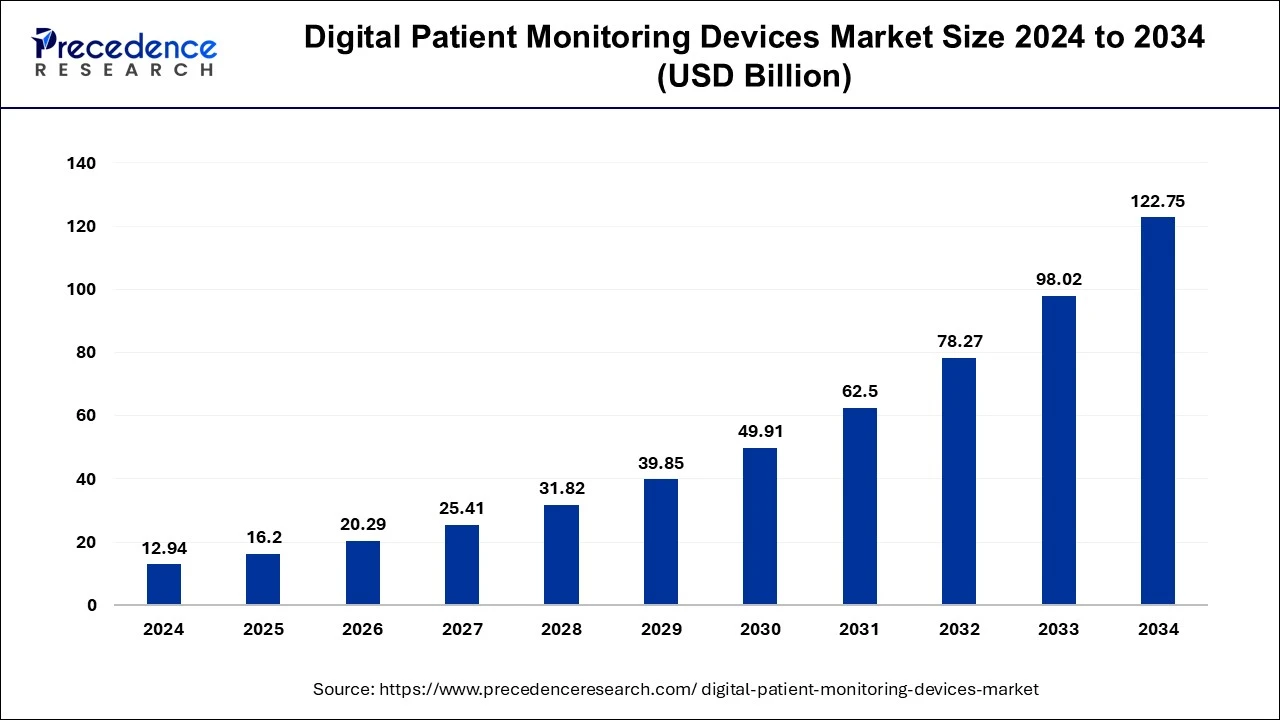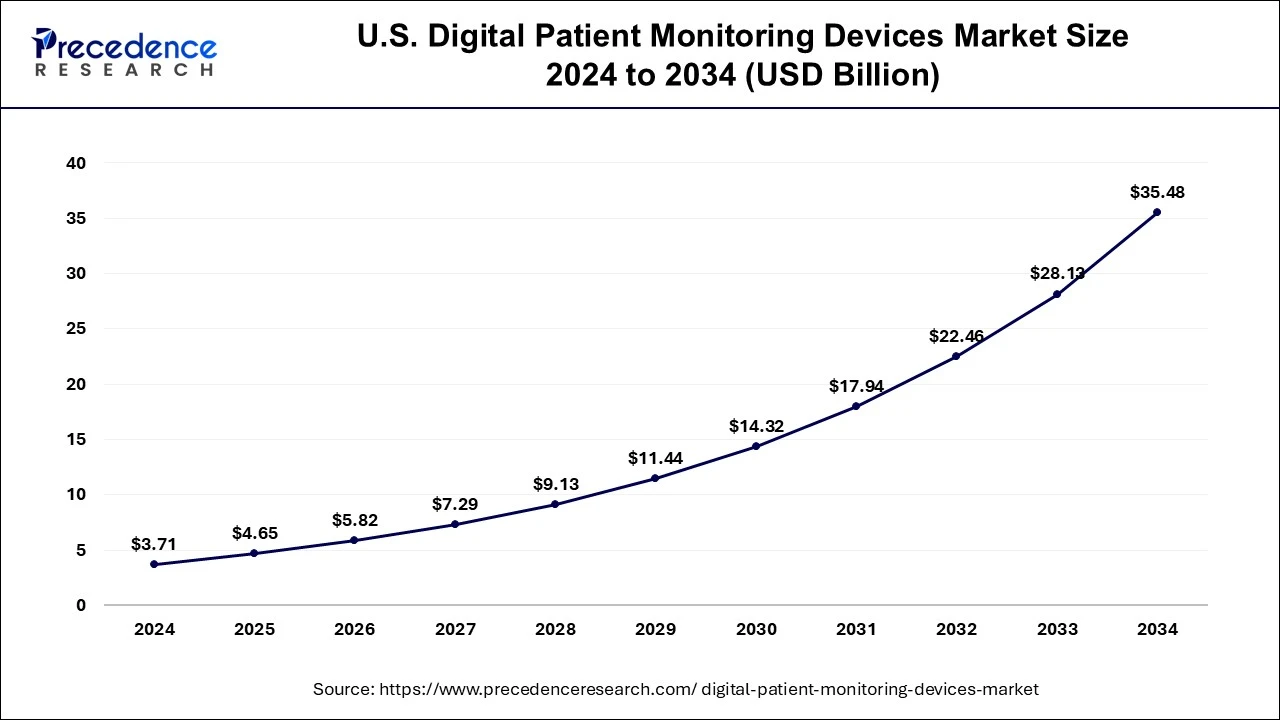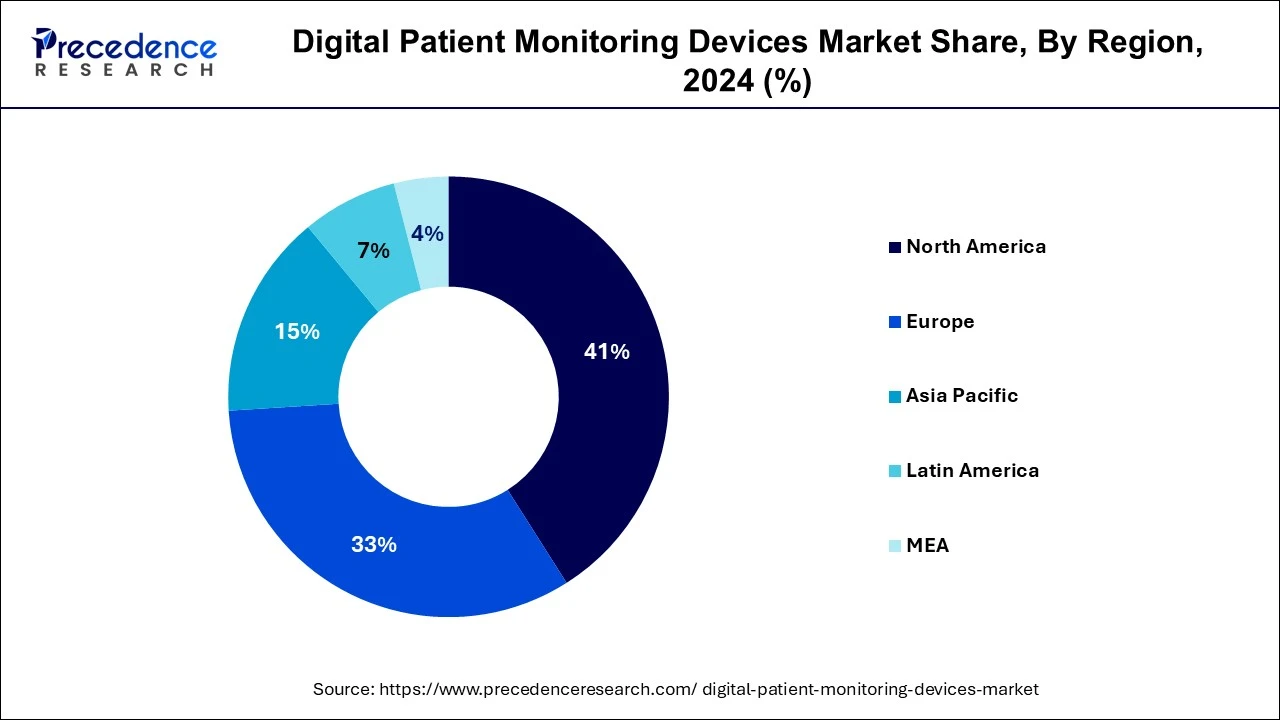List of Contents
Digital Patient Monitoring Devices Market Size and Forecast 2025 to 2034
The global digital patient monitoring devices market size was estimated at USD 12.94 billion in 2024 and is anticipated to reach around USD 122.75 billion by 2034, expanding at a CAGR of 25.23% from 2025 to 2034.

Digital Patient Monitoring Devices Market Key Takeaways
- North America dominated the digital patient monitoring devices market with share of 41% in 2024.
- Asia Pacific is expected to grow with the highest CAGR during the forecast period.
- By type, the wearable devices segment led the industry.
- By type, the mHealth segment is likely to experience the fastest growth rate during the forecast period.
- By product, the diagnostic monitoring devices segment held the largest share of the market.
- By product, the therapeutic monitoring devices segment is projected to witness the fastest CAGR during the forecast period.
What is the Role of AI in Digital Patient Monitoring Devices?
AI plays a significant role in the digital patient monitoring devices market. The integration of artificial intelligence AI in patient monitoring devices helps in enhancing patient care and enabling early interventions. Also, AI-based devices help in analyzing patient data for healthcare providers to identify health issues and take action as per requirement. Moreover, AI algorithms help in detecting subtle changes in vital symptoms that may indicate potential health risks associated with different patients.
- In October 2024, Samsung launched an AI-based device named as Galaxy Ring. This device comes with advanced features that helps in remote health monitoring.
U.S. Digital Patient Monitoring Devices Market Size and Growth 2025 to 2034
The U.S. digital patient monitoring devices market size was evaluated at USD 3,71 billion in 2024 and is predicted to be worth around USD 35.48 billion by 2034, rising at a CAGR of 25.32% from 2025 to 2034.

North America dominated the digital patient monitoring devices market. The rising prevalence of diabetes among people is driving the market for digital patient monitoring devices in the U.S. Also, the government of Canada and the U.S. has made several investments for advancing technologies related to healthcare sector. Moreover, the healthcare providers are adopting wireless monitoring devices for detecting the health conditions of the people of this region. Furthermore, the presence of several companies such as Abbott, GE Healthcare, VitalConnect and some others has played a crucial role in shaping the industry in a positive direction.
North America dominated the digital patient monitoring devices market due to technological advancements in healthcare infrastructure and awareness regarding the optimization of government and private insurance policies. The advanced infrastructure provides individuals with the topmost clinical facility that helps prevent chronic diseases that require long-term medical attention.
Early detection assists in identifying and prescribing medication for chronic diseases, and monitoring devices significantly improve the prevention of diseases, as they provide real-time tracking of patient data and continuously measure oxygen saturation, blood glucose levels, and heart rate. In addition, Canada also plays a crucial role as it provides patients with government initiatives and promotes awareness regarding the adoption of digital monitoring devices.

Asia Pacific is expected to grow with the highest CAGR during the forecast period. Due to increased prevalence of chronic disease and the growing elderly population, as well as the growing number of smartphone users across the region, Asia-Pacific is predicted to see significant market expansion in the digital patient monitoring devices market. Also, government of several countries such as India, Japan, South Korea and some others have launched several digital patient monitoring platforms to enhance the healthcare procedures. Moreover, the rising awareness of telehealth services among the people is likely to propel the growth of the digital patient monitoring devices market in this region.
In Europe, the digital patient monitoring devices market is experiencing rapid growth, fueled by a combination of factors including a diverse and growing patient population base of chronic patients, the presence of strong healthcare infrastructure, smart handheld devices, and an increasing emphasis on the adoption of digital health technologies like telemedicine systems. These dynamics contribute to the region's elevated demand for monitoring devices, particularly among patients with cardiovascular diseases.
European consumers exhibit a wide range of preferences, from those seeking affordable digital devices to those desiring personalized smart devices that provide 24/7 monitoring devices that enhance patient engagement. Moreover, Germany is home to a robust healthcare system that includes digital health apps and government initiatives, which reinforce a strong presence in the market for telemedicine platforms.
Market Overview
Digital patient monitoring devices market is a subset of telehealth market that uses digital technologies to collect medical and other types of data about patients outside of the healthcare system. The blood pressure, blood sugar, weight, and oxygen levels are all examples of data that can be sent to healthcare professionals or doctors using a telehealth computer system and software that can be loaded on a smartphone, computer, or tablet. Digital patient monitoring devices assists health workers in monitoring the condition of patients from all over the world and enhancing the quality of care provided to each and every patient.
The surge in demand for digital patient monitoring tools for chronic disease management, as well as the robust growth of the geriatric population worldwide with ailments that require quick treatments, such as heart stroke, diabetes, and chronic diseases is the fundamental factors driving the market demand for digital patient monitoring devices. This industry is expected to rise significantly with the growth of the medical devices industry in different parts of the world.
Digital Patient Monitoring Devices Market Growth Factors
- Increasing prevalence of chronic diseases such as cardiovascular diseases, diabetes, & hypertension and some others.
- Rapid adoption of these devices to improve service quality and cut costs.
- Rising healthcare expenditure in emerging nations.
- Advancements in healthcare technology.
- Growing trend of wireless monitoring devices.
- Launch of several IoT-based health monitoring devices.
- The rising awareness of telemedicine across the world.
- Increased application of these devices in hospitals and clinics.
Market Scope
| Report Coverage | Details |
| Market Size in 2024 | USD 66.8 Billion |
| Market Size in 2025 | USD 66.8 Billion |
| Market Size in 2034 | USD 66.8 Billion |
| Growth Rate from 2025 to 2034 | 21.1% |
| Largest Market | North America |
| Base Year | 2024 |
| Forecast Period | 2025 to 2034 |
| Segments Covered | Type, Product, and Region |
| Region Covered | North America, Europe, Asia-Pacific, Latin America and Middle East & Africa |
Market Dynamics
Driver
Rising Demand for Smartwatches
The trend of wearables has grown rapidly in different parts of the world. Among the wearables, the demand for smart watches has increased significantly for monitoring several health conditions such as blood pressure, glucose, oxygen level and some others. These smart watches are integrated with advanced technologies for providing accurate insights about human body. Moreover, these devices can be connected with smartphones and can be used via different apps. Thus, the growing demand for smartwatches to enhance remote patient monitoring is expected to boost the market growth.
- In September 2024, Amazfit launched GTR 4 smartwatch in India. This smartwatch comes with several healthcare features such as sleep monitoring, heart rate monitoring and stress monitoring.
Restraint
Internet Problems & Lack of Knowledge
The lack of adequate internet connectivity in developing and underdeveloped regions, as well as a lack of knowledge and value recognition of digital patient monitoring devices, are projected to restrain the global digital patient monitoring devices market growth during the forecast period.
Opportunity
Advancement in Sensor Technology
There are different types of sensors used in healthcare monitoring devices that helps in detecting numerous health conditions in patients. Nowadays, the application of wearable sensor has increased rapidly for several applications such as detecting heart rate, blood pressure, and oxygen levels. Moreover, the growing adoption of implantable sensors for monitoring internal organs has gained traction. Thus, advancements in medical sensors is expected to create opportunities for the market players in the upcoming days to come.
Value Cain Analysis
- R&D: The research and development phase involves innovating new digital patient monitoring devices and improving upon established technologies.
Key Players: Koninklijke Philips N.V., and GE HealthCare
- Clinical Trials and Regulatory Approvals: At this stage, it is necessary to carry out studies to prove that the device is safe and effective, and to secure the approvals from the respective regulatory bodies.
Key Players: Abbott, Medtronic, and Philips
- Formulation and Final Dosage Preparation: In association with digital patient monitoring devices, this mainly covers the design, engineering, and manufacturing to realize a hardware/software solution that performs per specification.
Key Players:Medtronic, Philips, and GE HealthCare
- Packaging and Serialization: The next stage is packaging for the digital patient monitoring devices and placing the serialization system that badges traceability requirements against any counterfeiting and against regulatory compliance.
Key Players: Amcor Plc and DuPont de Nemours
- Distribution to Hospitals, Pharmacies: It consists of building channels and logistics to deliver the digital patient monitoring devices to healthcare providers and retail pharmacies.
Key Players: UPS Healthcare, DHL Supply Chain, and FedEx Healthcare Solutions
- Patient Support and Services: Installation, training, maintenance, and technical support for patients, plus healthcare providers, are all covered by this category.
Key Players: Medtronic, VitalConnect
Type Insights
The wearable devices segment led the industry. The wearable devices consist of blood pressure monitors, wearable ECG monitors, wearable biosensors and some others. The wearable device adoption across numerous application sectors, customer preference for linked devices, and the growing population of internet of things IoT and related devices are all driving the growth of the wearable devices segment. This, in turn drives the market growth.
The mHealth segment is likely to experience the fastest growth rate during the forecast period. Growing smartphone and internet connectivity penetration, as well as supportive government initiatives, is among the primary factors driving segment expansion. The segment is predicted to rise due to rising demand for preventative healthcare and increased funding for mHealth entrepreneurs. The rise in number of mHealth platforms and mobile apps is driving the market expansion.
Product Insights
The diagnostic monitoring devices segment held the largest share of the market. The growth of the segment can be linked to an increase in demand for diagnostic monitoring devices that measure, record, distribute, and show a variety of biometric parameters such as temperature, oxygen, and blood pressure. The technological advancements in diagnostic monitoring devices for providing accurate insights about the health condition of the patient is driving the market growth.
The therapeutic monitoring devices segment is projected to witness the fastest CAGR during the forecast period. The rising prevalence of chronic diseases such as cancer in emerging nations such as China and India are predicted to present a wide range of potential prospects for therapeutic monitoring devices competitors. The rapid adoption of these devices for analyzing the effect of medicines in human beings has driven the industrial expansion.
Key Companies & Market Share Insights
Due to the company's strong focus on research and development (R&D), Philips N.V. occupied a prominent position in the market. Maternal Patch and Pod and Avalon CL, an obstetrics monitoring solution, will be available in the U.S. in June 2020. The key market players are adopting marketing strategies such as partnership, acquisition, merger and acquisition, and joint venture to create prominent position in the digital patient monitoring devices market.
Digital Patient Monitoring Devices Market Companies
- Siren
- GE Healthcare
- ResMed
- AT&T
- ATHENAHEALTH Inc.
- FitBit Inc.
- Koninlijke Philips N.V. AB
- Abbott
- Garmin Ltd.
- VitalConnect
Industry Leaders' Announcements
- In October 2024, Robert B. Ford, the CEO of Abbott announced to revamp FreeStyle Navigator. FreeStyle Navigator is a diabetes monitoring device that is expected to cater around 500 million diabetes patients across the world.
Recent Developments
- In May 2025, the Remote Monitoring Leadership Council, formed by top digital health companies, aims to expedite the nationwide adoption of remote patient monitoring technologies.
https://www.medicaleconomics.com - In February 2025, Validic introduces a patent-pending digital remote patient monitoring assistant using Generative AI, enhancing healthcare providers' understanding of patients' health trends.
https://www.businesswire.com
KORE
- In April 2025, KORE, an Australian company, and mCare Digital announced the launch of a smartwatch created for virtual patients.
Aster Healthcare
- In August 2024, Aster Healthcare aimed to improve patient care by providing 24/7 communication services.
iRhythm Technologies
- In August 2024, iRhythm Technologies launched Zio Cardiac Arrhythmia Monitoring Service.
Segments Covered in the Report
By Type
- Wireless Sensor Technology
- mHealth
- Telehealth
- Wearable Devices
- Remote Patient Monitoring
- Hospital Inpatient
- Ambulatory Patient
- Smart Home healthcare
By Product
- Diagnostic Monitoring Devices
- Vital Sign Monitors
- Sleep Monitors
- Fetal Monitors
- Neuromonitors
- Other Monitors
- Therapeutic Monitoring Devices
- Insulin Monitors
- Respiratory Monitors
- Other Monitors
By Region
- North America
- Latin America
- Europe
- Asia-pacific
- Middle and East Africa
For inquiries regarding discounts, bulk purchases, or customization requests, please contact us at sales@precedenceresearch.com
Frequently Asked Questions
Ask For Sample
No cookie-cutter, only authentic analysis – take the 1st step to become a Precedence Research client